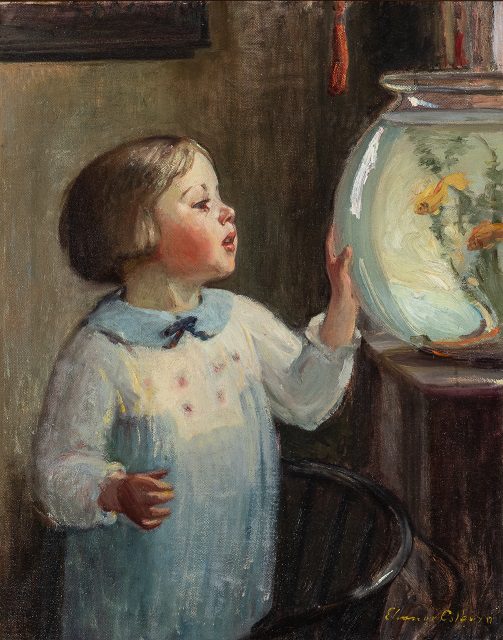Little Mary

Elanor Colburn
Little Mary
Oil on canvas, c. 1920s
25 x 20 inches
Gift of Ruth Colburn Peabody
2021.003.002
A little girl is shown absorbed in the contents of a large fish bowl in Elanor Colburn’s Little Mary. Light from a window at the upper right illuminates the full glass vessel, which transmits its glow to the girl’s uplifted face. Wearing a pale white-and-blue smock dress with a rounded collar completed with a small bow, the child personifies an ideal of youthful innocence with her rapt gaze, slightly parted lips, and full pink cheeks. Seemingly unaware of the viewer, she enacts the enchantment of discovery and childhood’s inexhaustible appetite for new experiences. In this case, the image hints, curiosity has driven the little girl to scramble onto the seat of the low-backed Windsor chair to reach the perhaps-forbidden object of her fascination, perched high on a stand.
The little girl’s identity is unknown. Inscribed Little Mary, presumably by the artist, on the back of the canvas, Colburn’s painting was probably made on commission for the model’s fond relatives. Colburn had exhibited both portraits and generic images of children, along with mother-and-child works, early in her career. These subjects remained staples of her work despite a radical shift in her painting in the mid-1920s, after the artist relocated from the Chicago area to Southern California. Little Mary manifests a conservative, academic impressionist style consistent with Colburn’s earlier work. Yet other evidence suggests it was painted even as the artist was experimenting with a new artistic approach, one in which she would abandon the conventional representation, hint of narrative, and conventional sentiment shown here for a new focus on the formal design elements of composition and color arrangements. Colburn signed the canvas with the modified spelling of her first name that she adopted in 1927, a date consistent with the style of the child’s dress and hair. Little Mary perhaps demonstrates the artist’s adaptability to the tastes and expectations of patrons, as well as its era’s ideal of childhood as a time of innocence, purity, and boundless expectation.
– Wendy Greenhouse, PhD






